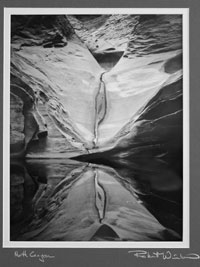| ||
Travels with a camera by Jules Masterjohn Though I had never met Robert Winslow, as he handed me his black, leather-wrapped portfolio, I felt at ease. His gentle manner and kind eyes told me that I was in the presence of not only a world-class photographer, but a sensitive soul as well. I unfolded the heavy cowhide package carefully, not knowing quite what to expect. Inside, I found the color photographs, laminated on a rigid fiberboard with felt backings on each photograph. Engrossed in the gorgeous images, I hardly noticed that the soft felt backing helped each photo slide easily to reveal the next image. This tactile and hands-on presentation of work was perfectly congruous with the types of images I was viewing – textural, patterned and visceral. The photographs that Winslow presented to me are a sampling of the work that occupied his early years as a photographer. Back then, he used a medium-format camera and printed his own photographs from color transparencies using a Cibachrome darkroom process known for its archival longevity, intensity of color and clarity of image. A luscious, blue-green toned image covered with small crusty patterns caught my eye. “What do you think that is?” Winslow asked. Knowing that he is currently a wildlife photographer, I thought the image might be a whale covered in barnacles. I was close – it was a close-up shot of the side of a boat in Thailand. From the East we traveled, via his photographs, to Death Valley. The next photograph’s frame was filled with subtle brown values describing, through the tiniest rippled texture, very large sand dunes. So soft, the dunes took on a sensuality that made my mind think I was seeing a reclining woman’s body instead of giant hills of sand. Back in Colorado, I easily recognized a shot looking straight up into an aspen tree’s branches. This image is different than the countless aspens that photographers document. Winlsow’s tree is like blazing golden lace against a velvety black background. In another photo, the plates of a crocodile’s skin become, for Winslow, a study in pattern and color. He was intentionally creating abstract images of nature with his camera, using close up perspectives that do not reveal the whole subject. In the beginning of his 25-year career, his interest was occupied by creating photographs that were primarily simplified compositions of patterns, colors, textures and forms within his camera’s lens. Winslow’s love of abstraction was influenced by one of his mentors, Brett Weston, son and colleague of modern master photographer, Edward Weston. While teaching wilderness studies at Idaho State University in the ’70s, Winslow was introduced to Weston through his fine art photographer instructor and friend of Weston’s.
Meeting his mentor was not the beginning of his relationship with photography – it had begun many years before. At age 12, Winslow’s aunt and uncle gave him a box camera that they bought while traveling in Germany. From that time on, he owned instamatic cameras. His first “real” camera, which accompanied him during a continuous 2,000-plus-mile trek along the Appalachian Trail in 1971, had no light meter. This forced him to learn photography through trial and error. “I wrote down all of the exposures in a notebook, one for each shot, so that I could learn the best camera settings for different light conditions,” Winslow recalled. His destiny as a photographer revealed itself when his Appalachian adventure ended. Fourteen of Winslow’s photographs were published in Hiking the Appalachian Trail, published by Rodale Press, a leading publisher of books and magazines on health and wellness lifestyles. Since then, Winslow has received many awards and recognitions to his credit and is well known for his images of wildlife and the natural world. Thousands of his photographs have appeared in publications such as Audubon, National Geographic Traveler, Outside, Sierra and World Wildlife Fund. Two of his photos of animals are reproduced on the tails of Frontier Airlines planes. Winslow does most of his business in the electronic world via his website – the days of presenting actual photographs bound in a leather portfolio are long gone – except for quirky folks like me. His website shows his recent works – a hundred or more images – and viewing them is like taking a journey around the world. If a trip into Winslow’s photographic past is appealing, he is presenting his early work at the Durango Arts Center on Sat., Nov. 11, from 4-7 p.m. This is an opportunity to view and purchase Winslow’s more abstract work, compositions dominated by patterns, texture and colors. These days, Winslow spends his time traveling with his camera – he has photographed in every state in the union and in countries all around the world. Each year he leads a photographic trip to Kenya, where he feels it is a privilege to be photographing wildlife. “We go to photograph when the animals are migrating. They – the wildebeests, zebras and gazelles – are following this ancient rhythm that has occurred for thousands of years. Witnessing this brings me in touch with the elemental essence that is us.” • For information about Winslow’s work, call 259-4143 or go to www.robertwinslowphoto.com.
|
In this week's issue...
- May 15, 2025
- End of the trail
Despite tariff pause, Colorado bike company can’t hang on through supply chain chaos
- May 8, 2025
- Shared pain
Dismal trend highlights need to cut usage in Upper Basin, too
- April 24, 2025
- A tale of two bills
Nuclear gets all the hype, but optimizing infrastructure will have bigger impact


